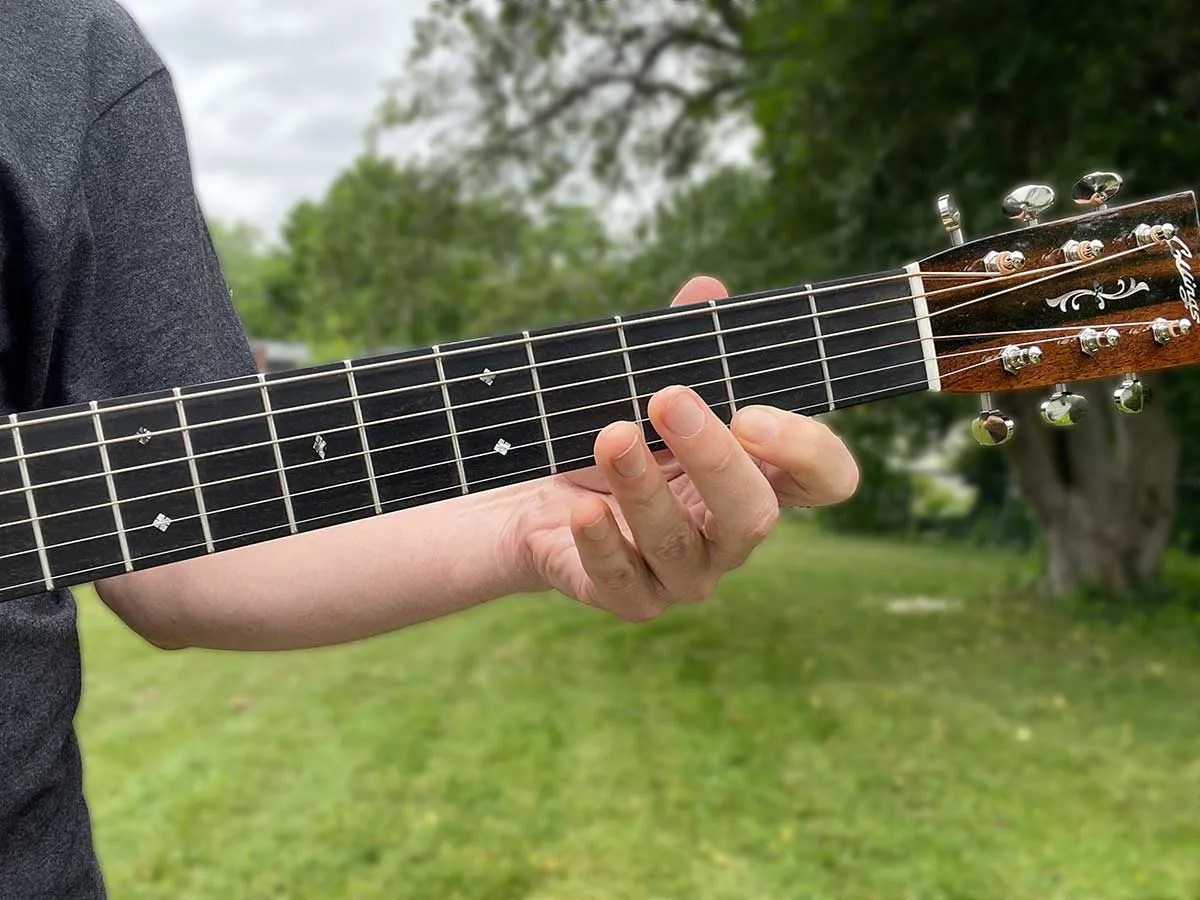
How to Create a Solo Using Scale Notes and Chord Shapes
Say you’re sitting in a circle at a jam session, and someone kicks off a nice, simple song with a repetitive progression and just a few chords—easy to strum along with. Then after a few verses and choruses, it’s time for instrumental breaks. Wouldn’t it be cool to take one, improvising a solo for a cycle or two of the chord progression?
It would be cool, and you can do it even if you usually stick to rhythm playing. All you need are some straightforward ingredients that are right at your fingertips.
In the first installment of this series on soloing basics (July/August 2025), we played solos on a 12-bar blues using only five notes—the minor pentatonic scale—in open position. Now we’ll apply a similar approach to a folk/country chord progression, drawn from a three-chord classic: John Prine’s “Speed of the Sound of Loneliness.” We’ll start by building a vocabulary of notes to use, then we’ll take a series of solos over that song’s progression.
Scale UpIn the previous lesson we played over a blues progression in the key of E, while this time we’re going to be in the key of G. Good news, though: the notes of the E minor pentatonic scale, which we used for blues in E, also very conveniently work in G major. That’s because the keys of E minor and G major are relatives: they have the same notes in their scales (and the same key signature, with one sharp, F♯).
Check it out. Example 1 shows the E minor pentatonic scale. If you add two notes, F♯ and C, that are not included in the five-note pentatonic, you get a G major (or E minor) scale. Example 2 shows that scale from the lowest to highest notes available in open position. The numbers indicate each note’s scale degree in G major, from 1 (root) to 7. These are the notes we’ll use to build solos for our G major progression.
To help get these scale notes in your ears and under your fingers, play a series of four-note phrases. Take these one measure at a time. In Example 3a, play four consecutive scale notes, first ascending the scale and then descending. I’ve written out just a few possibilities; pick any note in the scale and do the same thing, playing up or down the scale.
Next, play four consecutive scale notes but change direction, as in Example 3b. In Example 3c, skip over scale notes; in the first measure, for instance, jump from B on the fifth string down to the open sixth string.
In Example 3d, add a pair of eighth notes into each one-measure phrase, placing the eighths on different beats, and in Example 3b, play eighth notes for half the measure. For all these examples, play the phrases as written to get started, then make up your own variations, starting on different scale notes on all the strings.
Solo TimeNow we’re ready to jump in and take some solos. “Speed of the Sound of Loneliness” uses the same eight-bar progression through the whole song, both verse and chorus: G–C–D–G, two bars for each chord. In the video I play the rhythm part with a basic boom-chuck: bass notes on beats 1 and 3, strums on 2 and 4. I do the eight-bar rhythm part twice, so you can loop each example for practice.
To construct solos, bear in mind the core principles introduced in the last lesson. First, play phrases with breathing room between them, as in a vocal melody, rather than playing a continuous stream of notes. Second, create and repeat patterns—rhythmic or melodic or both—so your solo hangs together.
For our first take, Example 4, keep it really simple, playing quarter and half notes and a few longer notes that ring out at the end of phrases. Notice that the rhythm pattern in the first two measures is the same as in measures 5–6, with different pitches. The solo establishes a little rhythmic motif that you can continue to repeat or play off of.
The second solo, Example 5, adds a tad more rhythmic complexity but also uses a repeating rhythm. Measures 1, 3, 5, and 6 follow the same pattern: dotted quarter (one and a half beats), eighth, quarter, quarter. That repetition helps make the solo sound like a mini composition rather than just a series of scale tones. When you make up your own solos, pay attention to the patterns you create and use them—they’ll give shape and direction to your solo.
Follow the ChordsAny notes of the G major scale will work over the entire progression, but the chords of course are changing from G to C to D and back to G. You can reflect those changes in your solo by highlighting notes from each new chord along the way. We did the same thing in one example in the last lesson, playing the root of each new chord on the downbeat.
The easiest way to find those chord tones is just by picturing the open chord shapes. As you solo over a G chord, for instance, visualize the G shape, like a hologram over the fretboard, and land on open strings or fretted notes in that shape. When the progression changes to C, do the same and play note(s) that are part of the C shape, and ditto on D.
Example 6 shows the notes in each chord that are available in open position, from the sixth string to the first. The notes in a G major chord are G, B, and D, and you’ll recognize the shape of the G chord as you play across the strings in the example. Notice that you’ve got both B and D notes available on the second string. The notes of a C chord are C, E, and G, and you can play both E and G notes on the sixth and first strings. The D chord has the notes D, F♯, and A, and you have F♯ notes on strings 1, 4, and 6.
The chord shapes are very clear in the solo in Example 7. On the G in measure 1, and then on the C and D, play the notes of each chord triad in succession—you’re essentially outlining the chords. Mark each new chord in the progression by playing the root right on the beat where the chord changes. When you spotlight chord tones like this, your solo clearly establishes the chord progression even without accompaniment.
Play off the MelodyYou can also use the song’s own vocal melody to guide your solo. In Example 8, we’ll take one more solo that echoes Prine’s melody in a few ways. This time we’ll play through the progression twice, for 16 bars.
If you listen to “Speed of the Sound of Loneliness” while counting out its meter in 4/4, one thing you’ll notice is that his phrases start around the middle of the measure—not on beat 1. For instance, in the lines “So what in the world’s come over you?” and “What in heaven’s name can be done?” in the chorus, the word what falls on beat 3 of the measure. The solo in Ex. 8 does that too, starting the phrases in measures 1 and 5, for instance, on beat 3.
This solo’s phrases also follow the general direction of Prine’s melody, which lays out in four lines: the first three lines descend, and the fourth ascends. In the solo, I’ve just added a couple of short fills between phrases, as in measures 8 and 13–14.
Now that you’ve played through these examples, it’s your turn. At the end of the video you’ll find an extended rhythm track to improvise over. Bearing in mind the G major scale notes, the chord shapes, and the phrasing of Prine’s melody, see what you can come up with. With a little practice making up your own solos, you’ll be ready at the next jam session to take one.










